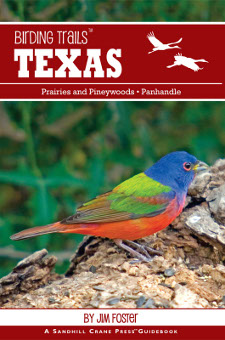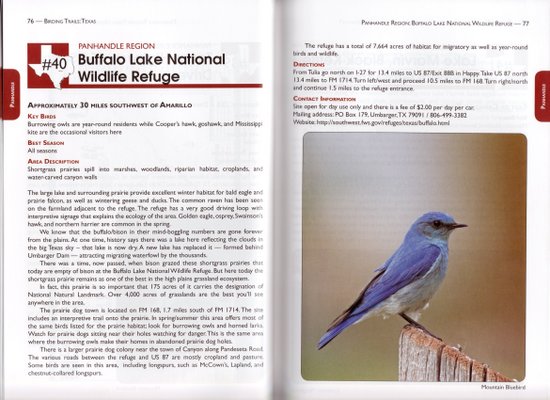Reviewed by Grant McCreary on October 21st, 2012.
Everyone knows that everything is bigger in Texas. That includes the state bird list (638 species!). It’s no wonder that Texas such a popular birding destination. But for most birders that means the Gulf Coast or Rio Grande Valley. That extended to bird-finding guides, as well. In fact, the majority of the state had never been served by such a guide. That changed recently with the publication of Birding Trails: Texas: Panhandle and Prairies & Pineywoods.
This guide covers 216 locations divided into three sections, roughly following the Great Texas Wildlife Trails: Panhandle, Prairie and Pineywoods East, and Prairie and Pineywoods West. The great diversity of habitats supports a great range of birds, from Lesser Prairie-chicken and Greater Roadrunner to Bachman’s Sparrow and Brown-headed Nuthatch.

The region covered
Bird-finding guides serve three main purposes: helping one find interesting places to bird, finding particular birds, and providing information on the given sites. Let’s see how this Birding Trails: Texas guide fares for each of these. Skipping to the last criteria, each of the site accounts here includes:
- Location – an address or brief description (i.e. “Approximately 30 miles southwest of Amarillo”)
- Key Birds
- Best Season
- Area Description – habitat(s)
- Detailed Description
- Directions – from a nearby city or intersection
- Contact Information – hours, fees, phone number, and website (when available)
The descriptions give a little taste of what the site offers not only in the way of birds, but also regarding its history and other wildlife. However, with so many sites included, the amount of coverage given each location is not that great; on average it’s just a page per site. It’s not as much as in many bird-finding guides, but for the most part seems sufficient to me. The directions, especially when an address is given, should also be sufficient to get you to the spot.
This guide should be successful in pointing out some good places to go birding. Maps at the beginning of each section show the location of each site, making it easy to find all the locations near wherever you might be. And the site descriptions give enough information for you to decide whether or not to go. Actually, I discovered several locations that I’d like to visit someday.
How about finding a particular bird? Birding Trails: Texas includes a complete Texas birds list, but that is basically a waste of space. Why include birds that have never been seen in the region covered here? Narrowing it down to just the birds that can be found in this region would have been much more helpful. And distribution bar graphs that give an idea of where and when the bird occurs are conspicuously absent. These are really important in some cases. For example, one site’s key birds include “migrating Mississippi kites” that “can be seen in season in large flocks overhead”. But when “in season” might be I couldn’t find anywhere.
Further, a separate list of specialty birds with the best sites to find them, always a handy feature in bird-finding guides, is missing here. At least you can find all mentions of a certain bird in the index. But it would have been much more useful if it weren’t so confusing! There are index entries for both families and individual species (by first name, oddly). For instance, “storks” and “wood stork” are both included, and yield identical results. However, “wood pewee” gives just one result, while “eastern wood pewee” gives many others, but not the single entry under the general name. And what in the world is a “black warbler”? In the end, you can use this guide to give you an idea of where to go for particular birds, but it is much more cumbersome and time-consuming than it should be.
Unlike most bird-finding guides, this one is profusely illustrated with some pretty nice color bird photographs. Overall, the layout and use of color are excellent and serve to make this book more user-friendly.
Even though I didn’t find it acknowledged anywhere, this guide is based closely on the Panhandle Plains and Prairies and Pineywoods Wildlife Trails developed by Texas Parks and Wildlife. That’s not a problem. However, a disconcerting amount of text in the book has been copied directly from the Wildlife Trails website (including mistakes!). This guide does contain information and insight not found on the website, but honestly, I think it needs more.
Recommendation
Birding Trails: Texas: Panhandle and Prairies & Pineywoods has some issues, but it should still be of use to resident and visiting birders of this region. If you’re visiting for a short time or primarily for something other than birding, the information on the Great Texas Wildlife Trails website should be sufficient. But for longer, dedicated birding trips I’d want to have this book with me.
Disclosure: I get a small commission for purchases made through links in this post.
Disclosure: The item reviewed here was a complementary review copy provided by the publisher. But the opinion expressed here is my own, it has not been influenced in any way.






Comment